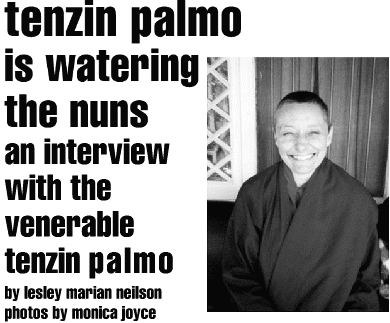 Tenzin Palmo is a Buddhist nun who is
becoming known around the world as the Englishwoman who spent
twelve years in a cave, high in the Himalayas. She is also a
Buddhist who has vowed to attain enlightenment in a woman's body,
challenging the institutionalized belief that only the male form
can reach liberation. Now, as she travels internationally giving
talks wherever she is invited to speak, in order to raise funds to
build a nunnery in northern India, Tenzin Palmo is a dynamic
incarnation of the emerging and powerful feminine principle in
Buddhism.
Tenzin Palmo is a Buddhist nun who is
becoming known around the world as the Englishwoman who spent
twelve years in a cave, high in the Himalayas. She is also a
Buddhist who has vowed to attain enlightenment in a woman's body,
challenging the institutionalized belief that only the male form
can reach liberation. Now, as she travels internationally giving
talks wherever she is invited to speak, in order to raise funds to
build a nunnery in northern India, Tenzin Palmo is a dynamic
incarnation of the emerging and powerful feminine principle in
Buddhism.
Tenzin Palmo's voice is clear and sweet as she talks
to me over the phone. It took two attempts to get a clear line
between this small town in the Kootenays, British Columbia, and
Dharamsala, India, where Tenzin Palmo is spending a few weeks
before returning to Kangra to look at land to purchase, on which
she will build the nunnery. It is to be known as Dongyu Gatsal
Ling, which means Delightful Grove of the True Lineage. Tenzin
Palmo has been working since 1993 to finance the project, and we
begin our conversation with her talking about the stage the
project has reached:
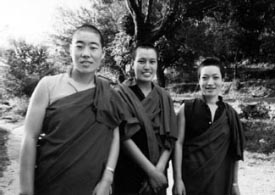 TP What we are doing is
starting a nunnery which will be especially for girls from the
Himalayan border region, including Ladakh, Bhutan and Lahul. These
are areas where there is a long tradition of Buddhism, but where,
although they have monks and nuns both, the nuns have really not
been given any opportunity for study or for deep practice. I lived
for many years in one of these Himalayan regions and I saw for
myself that essentially the nuns are just servants either to their
family or to the monks. And it's a pity because these girls are
very bright, very intelligent. As soon as they're given an
opportunity to study and to practise, then it's like they're tight
little buds which, if they're given enough sunshine and rain and
fertilizer, just open up and blossom. One is seeing that now.
Particularly from my tradition we want to encourage that. Because
there is nothing at the moment for these nuns.
TP What we are doing is
starting a nunnery which will be especially for girls from the
Himalayan border region, including Ladakh, Bhutan and Lahul. These
are areas where there is a long tradition of Buddhism, but where,
although they have monks and nuns both, the nuns have really not
been given any opportunity for study or for deep practice. I lived
for many years in one of these Himalayan regions and I saw for
myself that essentially the nuns are just servants either to their
family or to the monks. And it's a pity because these girls are
very bright, very intelligent. As soon as they're given an
opportunity to study and to practise, then it's like they're tight
little buds which, if they're given enough sunshine and rain and
fertilizer, just open up and blossom. One is seeing that now.
Particularly from my tradition we want to encourage that. Because
there is nothing at the moment for these nuns.
LMN Was it your experience in the monasteries when you
came over to India that really opened your eyes to the
inequalities between the nuns and monks?
TP Yes, well, it's just part of the social fabric. It
was not considered necessary for women to be educated, or for nuns
to follow the same kind of educational program as the monks.
Everybody accepted that's the way it was. Nowadays, more and more,
they are starting schools for nuns, where nuns can carry on the
same kind of educational curriculum as the monks. The nuns are
absolutely flourishing. They are doing so well, because they don't
just take it for granted. If someone does show an interest in
them, if people do think that the nuns have potential, then, as I
say, they absolutely flower, they really blossom. It's wonderful
to see it; it's terribly encouraging.
LMN What stage is the nunnery at now?
TP Well, on Sunday I have two friends coming, one from
Australia, one from Singapore, who have been helping with the
project, and we are going to go over all the land options which
I've seen in this area and make a final decision. And then we will
start the process for buying the land. Land in this area is quite
expensive. People are shocked at how expensive land in India
actually is nowadays. The fundraising has been very successful,
considering people only have my word for it. I think once we
actually get the land and gather the nuns, then people will really
understand that we are serious and fundraising will be easier.
LMN What are the challenges you face in building a
monastery for women?
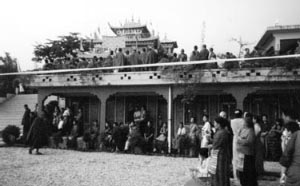 TP One of the problems is
finding adequate teachers. In my particular tradition there are
not that many qualified teachers of philosophy. And because they
will be teaching nuns, one has to be very careful. Inviting young
monks in to teach is sort of precarious, and older monks might
feel that there's not much status in teaching nuns. They may get
teased by other monks. They probably would feel quite lonely
because they won't have that kind of monastic community they're
used to. Obviously they can't socialize very much with the nuns.
And so this I see is going to be a challenge, finding good
teachers. In the future there will actually be nuns who will be
qualified to teach. There are some monasteries which are now doing
a full-scale educational program for the nuns, and some nuns have
been in that already for some years. So eventually they will be
qualified and then they could be invited to come and teach. That
would be ideal. Not only would there then not be the problem of
monks and nuns mixing, but also they would be a role model for the
younger nuns themselves—instead of always thinking it's the monks
who have the authority and the learning, and we're just women.
TP One of the problems is
finding adequate teachers. In my particular tradition there are
not that many qualified teachers of philosophy. And because they
will be teaching nuns, one has to be very careful. Inviting young
monks in to teach is sort of precarious, and older monks might
feel that there's not much status in teaching nuns. They may get
teased by other monks. They probably would feel quite lonely
because they won't have that kind of monastic community they're
used to. Obviously they can't socialize very much with the nuns.
And so this I see is going to be a challenge, finding good
teachers. In the future there will actually be nuns who will be
qualified to teach. There are some monasteries which are now doing
a full-scale educational program for the nuns, and some nuns have
been in that already for some years. So eventually they will be
qualified and then they could be invited to come and teach. That
would be ideal. Not only would there then not be the problem of
monks and nuns mixing, but also they would be a role model for the
younger nuns themselves—instead of always thinking it's the monks
who have the authority and the learning, and we're just women.
LMN Do you have a sense of why these changes are
happening now? What's allowing a tradition, which for thousands of
years hasn't had much of a place for women, to open up?
TP I think first of all there's a whole global interest
in women. That's the outer cause. One of the inner causes is that
nowadays the monasteries for the monks are pretty well
established. Previously, when the Tibetans came out as refugees,
their first aim was to get themselves re-established, to rebuild
the monasteries, to see that everything didn't die out. There was
a kind of desperation. That now has been taken care of. There are
dozens if not hundreds of monasteries, thousands of monks—the
tradition is not in danger of dying out. That's one thing. Now
they have the space to begin to realize there is a whole other
side to Buddhism; there is a whole female side.
The other thing
is that through the years there have been a number of Western nuns
who have become very well educated, often already with MAs in
Buddhist philosophy from Western universities, who have come and
studied, for example at the dialectic school in Dharamsala, and
who have done extremely well. That has also opened up the eyes of
the establishment. They see that women can be very well educated,
that they can hold their own. Some of them have started small
centres where women can study philosophy and have arranged for
them to begin an academic program. Once it gets started, the
momentum takes over, because these girls are intelligent, they are
very devoted and they are very capable of learning. Once people
begin to see that, they begin to take an interest and realize that
there's this whole half of the population which up to now has been
ignored. So even in the last ten years it's amazing. I mean
previously you hardly saw any nuns anywhere, they were a
non-presence. Now you see them all over, looking very bright, very
confident, very capable. They are lovely girls.
LMN So why in the past would a girl have become a nun?
TP In Asia, even in Buddhist countries, you have two
options: either you get married or you become a nun. For some
girls, they just didn't want the household life. Their feeling was
as a nun, even though there were many disadvantages, they were
comparatively freer, and they could lead a life of virtue and pray
hard, and next lifetime come back in a male body and become a
monk.
LMN The idea that only those in the male body can be
enlightened is being widely challenged these days with so many
Buddhist women starting to be teachers. You have vowed to attain
liberation as a woman and are now building a nunnery to support
other women in their spiritual life. What will the nuns be
learning?
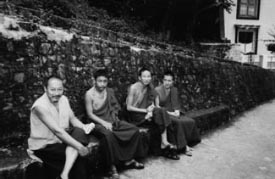 TP One of our plans is to
re-establish what is called the Togdema lineage, which is a
lineage of yoginis. Our monastery is very special in having a
lineage of yogis (Togdens) who follow the Milarepa tradition. In
Tibet there were also the female equivalents which now we don't
have any more. I think they were wiped out during the Cultural
Revolution. If we can re-establish that lineage with nuns who
already have had a basic philosophical education and on top of
that are doing profound practices, then I see no reason at all why
in the future they shouldn't become well-qualified teachers. At
the moment in the Tibetan tradition there is a great dearth of
female teachers. I can only think of two female lamas in the
Tibetan tradition. And both of them are closely connected with
high lamas: one is a sister, one is a daughter of a very high
lama. Both are very extraordinary and wonderful, but there are
only two! So we need a few more.
TP One of our plans is to
re-establish what is called the Togdema lineage, which is a
lineage of yoginis. Our monastery is very special in having a
lineage of yogis (Togdens) who follow the Milarepa tradition. In
Tibet there were also the female equivalents which now we don't
have any more. I think they were wiped out during the Cultural
Revolution. If we can re-establish that lineage with nuns who
already have had a basic philosophical education and on top of
that are doing profound practices, then I see no reason at all why
in the future they shouldn't become well-qualified teachers. At
the moment in the Tibetan tradition there is a great dearth of
female teachers. I can only think of two female lamas in the
Tibetan tradition. And both of them are closely connected with
high lamas: one is a sister, one is a daughter of a very high
lama. Both are very extraordinary and wonderful, but there are
only two! So we need a few more.
LMN It seems a lot easier for a Western woman to make
her way up to being a respected spiritual teacher than it is for
Asian women.
TP Western women don't have the same social pressures
any more. And because the Tibetans or the Indians don't expect
anything of us anyway because we're not part of their social
patterning, it leaves us very free. But I think now it's the time
for the Asians themselves to begin to change their attitudes. And
they are. It is therefore important to give the opportunity to
these girls to study and get a sense of their own self-worth,
their own qualities. Not to become proud, obviously, but just to
have the confidence that they are capable of learning and
experiencing, and realizing they are capable of giving and helping
others. At the moment they don't have this because they always
look to the monks and the lamas.
LMN In your biography Cave in the Snow you say you are
primarily a contemplative practitioner. Now the work you are doing
is putting you right out into the world. How did this change in
focus happen?
TP Well, it wasn't something which I consciously chose.
When I moved to Italy I tried at various points to set up retreat
facilities and go into retreat, and every time there were very big
obstacles, mostly physical obstacles, but absolutely a door
slammed and said, no, that's not what you're supposed to be doing.
So I really wondered what I was supposed to be doing. I thought,
my whole life is given to the Buddha-Dharma-Sangha, what do you
want? Then when I returned to Asia after five years, the lamas in
my monastery said, look, we really need a nunnery, we don't have
one, and so you please start one. Immediately I thought, yes,
that's what I have to do. My own personal lama had previously
said, I would like you to start a nunnery. In fact, he said that
several times about twenty years ago, and I had just said, oh yes,
and ignored it. But this time when the lamas said, you should
start a nunnery, I thought, yes, now is the time.
So I then
got catapulted into these world tours and things like this, which
was the very last thing I would have ever considered myself ever,
ever doing. But it's really been good. Being in retreat develops
certain qualities, but being out in the world develops other
qualities you could never develop in a retreat. So although it's
absolutely not what I would have planned for myself, it's very
interesting to see how one gets carried along into doing all sorts
of things that one simply never would plan. Like being here now,
meeting with officials, dealing with Indian bureaucracy,
fundraising and dealing with accounts—all these things to which I
had never even given one thought to before. But that's how you
learn, is it not?
LMN What it is that you learn when you're out in the
world compared to what you can learn in a cave?
TP Well, in the cave you're there, and as I have often
said, it's in a way like peeling off layers of the onion, one's
usual identifications. When one is all by oneself, then playing at
various identifications is kind of boring, so you begin to ask,
who am I when I am not playing all these parts for people?
Whatever parts one happens to be playing—we play so many. It's a
much more introspective time. It's also a time for completely
concentrating on a very set practice and becoming a pressure
cooker in which all the energies and all the steam is building up
and not leaking out, so that things can get cooked quite quickly.
When one is in the world, one has to develop other skills. There
is more to the spiritual path than just meditation and
introspection. There are also the qualities of generosity,
patience, loving-kindness, compassion and so on, which you need to
have other people around to develop. It's easy to sit in a cave
thinking, may all beings be well and happy, but it's a different
thing if you're out in the marketplace meeting these beings, many
of whom are quite difficult to deal with. So that's when you
really develop those kind of social muscles.
One develops all
sorts of qualities in a social context that one cannot develop
alone, just as one develops many qualities alone that one couldn't
develop in a social context. It's like breathing in and breathing
out. We need to balance the two. I have certainly become more
forthcoming. I think when I was living in the cave it was a little
difficult to develop just how to be with other people. And now
constantly traveling around, you know, learning how to stay
focused and aware even in the middle of the marketplace is very
important.
LMN Do you receive a lot of mail now that Cave in the
Snow has been published? What do people want to know?
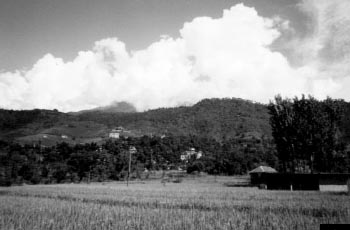
the settlement of Tashi Jong,
india
TP A lot of the people write to say they enjoyed the
book and thank you and so on. Fortunately, only people who like
the book bother to write. People who didn't like the book don't
write, so that's nice. I get a surprising number of letters from
people who had quite profound spiritual experiences in their
childhood or their adolescence, which completely transformed their
whole view of what life is about and who they are. But they were
living in a social context where nobody understood what they were
talking about and thought they were nuts. Even if they went to
their pastors or teachers, nobody knew what they were talking
about. So a number of them went into quite a heavy psychological
crisis because of this, because they were sure they had glimpsed
something that was more real, but there was no endorsement from
the environment and the culture around them. It's surprising how
many letters I get from people who have had these kinds of
experiences and are now so grateful to realize that what they had
understood intuitively wasn't crazy after all. In fact, they
really knew inside themselves that what they had experienced was
extremely valid.
Of course, then the next question is: What do
we do with it? How can we find a teacher? How can we find a path?
This is always very difficult. I don't know how to advise people
on that. I do what I can depending on the individual and where
they are, but it's very difficult nowadays for people to find
authentic teachers. Or to find an authentic path which would suit
them.
LMN In your own journey to find a teacher, you met him
fairly quickly.
TP Yes, that was very smooth running. Many people don't
have such good fortune. Also, in those days, if you did find your
teacher you could be with them. Whereas nowadays, even if you find
a teacher, they're never home. All these teachers are jet-setting
around everywhere; it's very difficult for people. If you're
lucky, you see them for five minutes once a year or something. Its
very difficult nowadays to create that genuine guru-chela
relationship because the teachers are so elusive, really. They're
spread so thin nowadays. Any teacher, especially if they speak
English, ends up with thousands of disciples running all over here
and there and everywhere and it's impossible to have a
person-to-person relationship. This is a big problem. Whereas when
I started, if you arrived in India and actually were interested in
the dharma, all the doors were opened. They were so excited that a
Westerner would be interested. Things have changed. So even though
they didn't speak English, and they didn't really know what to
teach you because they'd never had a Westerner before, nonetheless
the contact was there. It was very easy to contact everybody, from
the Dalai Lama downwards.
LMN How can teachers deal with this now? How is it going
to have to change with so many more disciples per teacher?
TP It's a problem. I think that what needs to be done is
that, perhaps except in exceptional cases, people have to rely
more on themselves and their own inner wisdom. Get the teachings,
get the instructions, understand what they're supposed to be doing
and then just settle down and do it, and make their own decisions.
Person-to-person contact with teachers these days is very rare.
I'm here at the moment in Dharamsala, which is a big Tibetan
centre, and again and again I have long-term Western students
coming and asking exactly this: How can I find a teacher? And here
we are with hundreds and hundreds of monks and lamas, but to
actually find a teacher and develop a relationship is not easy,
even here.
LMN Do you see women in Buddhism taking more of a
leadership role in the future? Would the nuns you are training
perhaps become spiritual teachers?
TP Finally there is a recognition of this female
element, and I think in the next ten years it will be very
interesting to see what happens once these nuns graduate from
their studies and become more mature figures, and to see what kind
of voice they are going to have in the society. I think that will
be very interesting. So to be a part of that is good, even though
sometimes it seems an impossible task. But actually things are
worthwhile. Because if we don't do it, nobody else is going to.
The lamas are not going to do it. The women have to help each
other, there's no doubt. To be part of that whole movement is
nice. It's very strong at this time; the impetus is really flowing
in full flood for helping these women. 
photos by Monica Joyce

